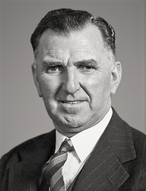1954 New Zealand general election
| ||||||||||||||||||||||||||||||||||
All 80 seats in the House of Representatives 41 seats were needed for a majority | ||||||||||||||||||||||||||||||||||
|---|---|---|---|---|---|---|---|---|---|---|---|---|---|---|---|---|---|---|---|---|---|---|---|---|---|---|---|---|---|---|---|---|---|---|
| Turnout | 1,096,877 (91.4%) | |||||||||||||||||||||||||||||||||
| ||||||||||||||||||||||||||||||||||
| ||||||||||||||||||||||||||||||||||
The 1954 New Zealand general election was a nationwide vote to determine the shape of the New Zealand Parliament's 31st term. It saw the governing National Party remain in office, but with a slightly reduced majority. It also saw the debut of the new Social Credit Party, which won more than eleven percent of the vote but failed to win a seat.
Background
The National Party had formed its first administration after the 1949 elections. It had then been re-elected by a large margin amid the industrial disputes of the 1951 election. The Prime Minister, Sidney Holland, was popular in many sectors of society for his strong line against striking dockworkers and coalminers, while Labour's leader, Walter Nash, had been criticised for his failure to take a firm stand on the issue. Labour was troubled by internal disputes, with Nash subjected to an unsuccessful leadership challenge only a few months before the election. For the election, the National government adopted a "steady as she goes" approach, saying that the country was in good hands and did not need any major policy realignments.
The election
The date for the main 1954 elections was 13 November. 1,209,670 people were registered to vote, and turnout was 91.4%. The number of seats being contested was 80, a number which had been fixed since 1902.
The following new (or reconstituted) electorates were introduced in 1954: Heretaunga, Manukau, Rotorua, Stratford, Waipa and Waitemata.[1] Two candidates, both called John Stewart, came second; in Auckland Central for National and in Eden for Labour.[2]
Ten MPs retired at the election, see cartoon.[3]
Results
The 1954 election saw the governing National Party re-elected with a ten-seat margin (and fewer votes than Labour), a drop from the twenty-seat margin it previously held. National won forty-five seats to the Labour Party's thirty-five. The popular vote was much closer, however, with the two parties separated by only 0.2%. No seats were won by minor party candidates or by independents, but the new Social Credit Party managed to win 11.2% of the vote, and it can be argued that Social Credit saved the National Government by providing an alternative to Labour and so minimising the two-party swing.[4]
| Election results | ||||||
|---|---|---|---|---|---|---|
| Party | Candidates | Total votes | Percentage | Seats won | change | |
| Template:Meta color | National | 79 | 485,630 | 44.3 | 45 | −5 |
| Template:Meta color | Labour | 80 | 484,028 | 44.1 | 35 | +5 |
| Template:Meta color | Social Credit | 79 | 122,573 | 11.2 | 0 | ±0 |
| Template:Meta color | Communist | 8 | 1,134 | 0.10 | 0 | ±0 |
| Template:Meta color | Independents | 9 | 3,474 | 0.40 | 0 | ±0 |
| Total | 255 | 1,096,877 | 80 | |||
Votes summary
Template:1954 New Zealand general election
- Table footnotes
Notes
- ^ Norton 1988, pp. 7–9.
- ^ Norton 1988, pp. 193, 220.
- ^ "The First Eleven (retiring MPs)". National Library of New Zealand.
- ^ Gustafson, Barry (1986). The First 50 Years: A History of the New Zealand National Party. Auckland: Reed Methuen. p. 66. ISBN 0-474-00177-6.
References
- Gustafson, Barry (1986). The First 50 Years : A History of the New Zealand National Party. Auckland: Reed Methuen. ISBN 0-474-00177-6.
{{cite book}}: Invalid|ref=harv(help) - Norton, Clifford (1988). New Zealand Parliamentary Election Results 1946–1987: Occasional Publications No 1, Department of Political Science. Wellington: Victoria University of Wellington. ISBN 0-475-11200-8.
{{cite book}}: Invalid|ref=harv(help) - Wilson, James Oakley (1985) [First published in 1913]. New Zealand Parliamentary Record, 1840–1984 (4th ed.). Wellington: V.R. Ward, Govt. Printer. OCLC 154283103.
{{cite book}}: Invalid|ref=harv(help)


